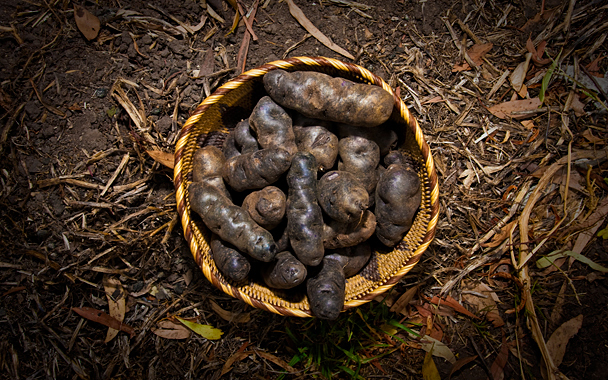In the first year of gardening, planning is sometimes more a matter of choosing which vegetables seem easiest to grow. Last year Stephen and I had a late start (early June), which made our plant choices fast and furious. In year two, I’m finding, our plan is much more from the heart.
As I mentioned last week, Stephen is obsessed with Sicilian varieties of squash and tomatoes and beans. And although I had chosen the greens and eggplant that I loved, I hadn’t been as reflective as my friend had about the foods that spoke to me of family.
While I am just learning about soil and seeds, two generations ago, my people were farm people. Both sets of grandparents were dairy farmers in New York’s North Country, and my mom’s parents also raised animals and grew all the food they needed to feed their five daughters—from chickens and pigs to lettuces and garlic. And rows and rows of spuds.
We are potato people. Mashed, fried, boiled, folded into a gratin, or latke’d, the potato is so popular with our family that one of my uncles once kidded my mother that she should have a spud engraved on her tombstone. When she died last year my sister and I, amid our tears, had a good laugh trying to imagine what a russet would look like etched in granite.
So just when I thought this year’s garden plan was pretty solid, I asked Stephen if we could spare some room for a few potato plants. First he groaned, because potatoes traditionally take up a lot of space in a garden (common wisdom says to plant them 18 to 24 inches apart). They’re also prone to more disease than other vegetables, such as wet-weather Phytophtora infestans (the blight that caused the Irish famine of 1844) and fungus, as well as attack from insects such as the Colorado potato beetle. But being the good garden mate he is, he said, “You got it. We’ll use row covers and bring in some ladybugs to control the beetles. What kind do you want to grow?”
Although my people are russet people, I’ve had my eye on the ancient purple Peruvian variety and the waxy, light yellow Russian banana fingerling. But before I decided, I called one of my favorite farmers, a man who talks straight and knows his spuds: Lee Jones at Chef’s Garden, in Huron, Ohio, who also supplies some of the finest produce in the country. Lee grows four acres of potatoes on his farm—Adirondack Blues, French fingerlings, German Butterballs, and a dozen other varieties—and his first advice was to grow what you love, whether it’s a red Norland or an all-purpose white-fleshed Kennebec. While the Peruvian may be “a little starchy and dry,” he said, it’s still tasty. The blossoms of the potato plant are the color of the vegetable itself, he reminded me, and potato flowers “are some of the prettiest there are.”
Next, he offered some advice on growing spuds in the home garden:
Always begin with certified seed potatoes from a reliable supplier, such as Maine’s certified-organic Wood Prairie Farm, or Seed Savers, instead of using potatoes you sprout at home. Seed potatoes are less likely to carry disease.
Quarter and cure your seed potatoes indoors for a couple of days before planting.
Plant closer than the 18 inches recommended in traditional garden guides. Planting closer, or even in a pot, if you don’t want to devote garden rows to spuds, will force the potatoes to be smaller, hence more tender. (Potatoes also prefer a slightly acid soil, of pH 5.8 to 6.5.)
Create a mound for your potato row and lay plastic or a biodegradable cover over the soil in early spring to warm the ground (for a second planting in warmer weather, use white plastic to slow the heat absorption). Cut a hole in the plastic and plant the seed potato 2 to 3 inches into the soil. As the plant grows, you will continuously mound soil around the growing plant (beneath the row cover).
Do 2 to 3 plantings a season. Plant now for “new” potatoes in around 7 to 8 weeks. Three weeks from now, plant again.
One way to help banish beetles and leaf hoppers organically is to apply a garlic-hot-pepper crop oil mix every other day. Consult your local greenhouse or Cooperative Extension Service for how to buy.
When you harvest your potatoes, make sure to dig in the soil a second time to unearth the tasty little nuggets that you may have missed the first time around.
In one week we’ve gone from “can I have a row of fingerlings?” to Stephen bringing in a couple of standard white and red varieties, and, despite the caveat from Farmer Jones, we’re going to give the Purple Peruvians a go. Maybe I just want to see those psychedelic purple flowers swaying in the garden a few weeks from now. Maybe I am fixated on making former Gourmet food editor Lillian Chou’s Papas a la Huancaína (Peruvian potatoes with cheese sauce), using my own vegetables. Or maybe, being from a long line of potato people, I see growing something with an 8,000-year history as something they’d very much approve of.

